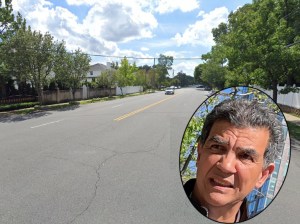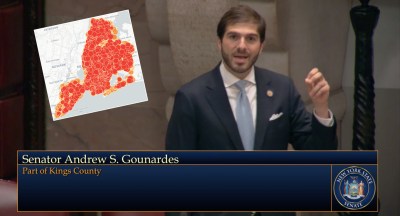Slow the F Down: City Seeks to Tame Drivers on Some Neighborhood Speedways

Mayor de Blasio just announced life-saving speed limit reductions on some of the city’s remaining neighborhood speedways, the first announcement of what the administration is calling “Streets Week!” (yes, with an exclamation point).
The reductions include a stretch of deadly Hylan Boulevard in Staten Island where the speed limit is the same as the FDR Drive, a highway. That proposed 10 mile-per-hour reduction is already being criticized by Staten Island pols as a “money grab” by the city, but in 2019 (the last full year for which there are good statistics), there were 528 crashes on Hylan between the Verrazzano bridge and Tottenville alone, injuring three cyclists, 48 pedestrians and 214 motorists, killing two drivers.
Since January, 2016, there have been 4,139 reported crashes along the same stretch, injuring 26 cyclists, 188 pedestrians and 1,042 motorists, killing five pedestrians and six drivers. That’s more than two crashes per day on just one roadway.
Most of the speed limit reductions can be done immediately, but reductions of 10 miles per hour or more require the DOT to send written notice to local community boards.
“I know some people gripe about it,” the mayor said on Monday, “but this is about saving lives.”
Pressed by Streetsblog to “make it personal” against politicians such as Council Member Joe Borelli who oppose speed limit reductions, the mayor declined to criticize elected officials, preferring to take the high road:
“I’ve gotten to know Joe Borelli over time and we don’t agree on many things, but I respect him as an individual,” the mayor said. “But I would just raise the facts: Hylan Boulevard, even with Vision Zero, we’ve seen too many people hurt and lives lost. And it’s clear you have to do something differently when you see that. So, no, you cannot have a higher speed limit. Lowering speed limits creates accountability and saves lives. It’s time. The facts point to it.”
Here’s a list of the roads with reduced speeds that the mayor announced on Monday:
Bronx
- Pelham Parkway from White Plains Road to Stillwell Avenue, from 30 to 25 MPH
- Throggs Neck Expressway Service Road N/S from Longstreet to Sampson/Ellsworth avenues, from 30 to 25 MPH
- Jerome Avenue from Bainbridge Avenue to East 233rd Street, from 30 to 25 MPH
Queens
- Woodhaven Boulevard from Queens to Rockaway boulevards, from 30 to 25 MPH
- Cross Bay Boulevard from Rockaway Boulevard to the Cross Bay North Boulevard Bridge, from 30 or 40 to 25 or 35.
- Van Wyck Service Road E/W from 135th Avenue to Queens Boulevard, from 30 to 25 MPH
- Astoria Boulevard from Eighth to 111th streets, from 30 to 25 MPH
- South and North Conduit avenues from Sutter Avenue to Sunrise Highway, from 35 to 30 MPH
Brooklyn
- Conduit Boulevard from Atlantic to Sutter avenues, from 35 to 30 MPH (connects to the above Queens strip)
Staten Island
- Hylan Boulevard from Bay to Massachusetts streets, from up to 40 miles per hour to 30 MPH.
Reducing speed limits on the lingering high-speed “arterials” has been a slow process for the city. In 2019, the city lowered the speed limit on the former West Side Highway, and, in response to a spate of deaths, on Brooklyn’s Hamilton Avenue that same year.
Dear #BayRidge,
Slow the F down!
Love,
Your Councilman pic.twitter.com/av4jK73Mm4— Justin Brannan (@JustinBrannan) August 7, 2018
Some local officials — including those who like to speed — complain of reductions in speed limits, but study after study shows that crashes decrease when drivers operate their motor vehicles more slowly. And the fatality rate from crashes also plummets when drivers are driving more slowly.
A pedestrian who is struck by a vehicle traveling at 30 miles per hour is twice as likely to be killed as a pedestrian struck by a vehicle traveling at 25, the mayor’s office said in a statement.
“Slower speeds save lives,” Danny Harris, executive director of Transportation Alternatives, said in a statement that pointed out that enforcement is only a small tool in the overall street safety toolbox. “Lowering speeds … will be even more effective when coupled with physical redesigns of streets and automated enforcement.” (Indeed, the mayor’s announcement did not mention anything about redesigning Hylan Boulevard, which will retain its speedway look.)
It’s worth noting that the cities where Vision Zero has actually reached zero — such as Oslo — have massive areas that are off limits to cars. The de Blasio administration has resisted that life-saving move.
This makes me happy:
Road deaths in Oslo (pop. 673.000) in 2019:
Pedestrians: 0
Cyclists: 0
Children: 0The graph shows the reduction of road deaths since 1975.
Article in Norwegian: https://t.co/9Dv2bLZlFT
#VisionZero pic.twitter.com/MCRFK1wPJ3
— Anine Hartmann (@aninehartmann) January 1, 2020
This is a breaking story. We’ll have more later.



